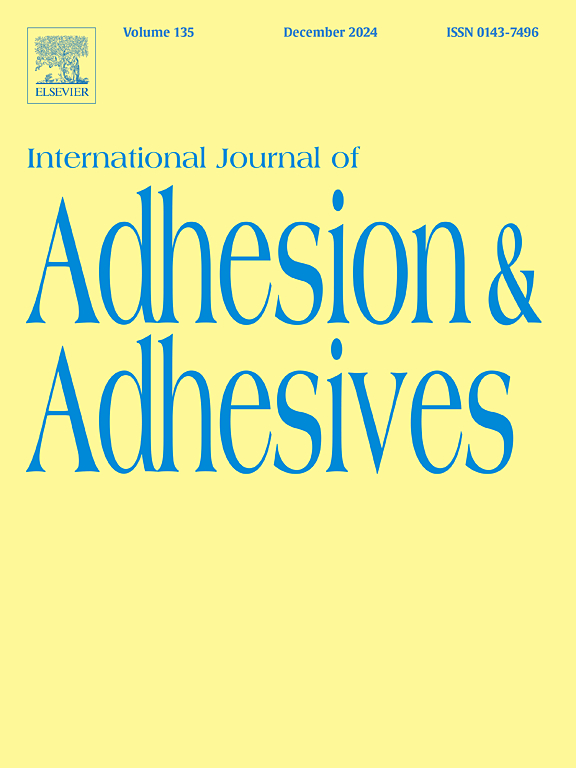Flaw classification in bonded joints using multivariate statistical analysis and artificial intelligence
IF 3.2
3区 材料科学
Q2 ENGINEERING, CHEMICAL
International Journal of Adhesion and Adhesives
Pub Date : 2025-04-12
DOI:10.1016/j.ijadhadh.2025.104032
引用次数: 0
Abstract
Adhesives play an important role in multiple industries, offering versatile bonding solutions for diverse applications. However, their incorporation in structures where safety is critical has been met with hesitation due to potential degradation risks. Addressing this concern, this study introduces the preliminary assessment of a pattern recognition method aimed at automatically identifying damage in adhesive joints through acoustic signal analysis. This method was tested on experimental samples consisting of aluminum substrates bonded with an acrylic adhesive. Artificially generated defects on the samples was related to the percentage of bonded surface. Damaged samples contained either 25 %, 50 %, or 75 % of bonded surface, whereas healthy samples contained 100 % of bonded surface. Experiments involved applying an impulsive load at one end of the sample and recording the acoustic signal emitted in response to the load using a microphone located at the opposite end. Two classification algorithms were evaluated for discriminating the amount of damage of the samples. First, a multivariate statistical analysis extracted the fundamental frequencies from the acoustic signals to create a model that achieved 95 % of classification accuracy. Second, an Artificial Neural Network (ANN) model was trained and validated with features extracted from the sound pressure level (SPL) signal obtaining an average accuracy of 97.1 % for a 9-fold cross-validation. The results indicate that there is potential for further exploration of the proposed approach, leading to the development of a robust system capable of automatically detecting damage in bonded joints. Future work will explore the performance of the classification techniques for detecting other types of defects related to the lack of adhesion and inadequate curing times.
利用多元统计分析和人工智能对粘接接头进行缺陷分类
粘合剂在多个行业中发挥着重要作用,为不同的应用提供了通用的粘合解决方案。然而,由于潜在的退化风险,它们在安全至关重要的结构中的应用一直犹豫不决。针对这一问题,本文介绍了一种通过声信号分析自动识别粘接接头损伤的模式识别方法的初步评估。该方法在由丙烯酸胶粘剂粘合的铝基材组成的实验样品上进行了测试。在样品上人为产生的缺陷与粘接表面的百分比有关。受损样品含有25%、50%或75%的粘结表面,而健康样品含有100%的粘结表面。实验包括在样品的一端施加脉冲负载,并使用位于另一端的麦克风记录响应负载而发出的声信号。对两种分类算法进行了评价,以区分样品的损伤程度。首先,通过多元统计分析,从声信号中提取基频,建立一个分类准确率达到95%的模型。其次,利用从声压级(SPL)信号中提取的特征对人工神经网络(ANN)模型进行训练和验证,经过9次交叉验证,平均准确率为97.1%。结果表明,该方法有进一步探索的潜力,从而开发出能够自动检测粘结接头损伤的鲁棒系统。未来的工作将探索用于检测与缺乏附着力和固化时间不足相关的其他类型缺陷的分类技术的性能。
本文章由计算机程序翻译,如有差异,请以英文原文为准。
求助全文
约1分钟内获得全文
求助全文
来源期刊

International Journal of Adhesion and Adhesives
工程技术-材料科学:综合
CiteScore
6.90
自引率
8.80%
发文量
200
审稿时长
8.3 months
期刊介绍:
The International Journal of Adhesion and Adhesives draws together the many aspects of the science and technology of adhesive materials, from fundamental research and development work to industrial applications. Subject areas covered include: interfacial interactions, surface chemistry, methods of testing, accumulation of test data on physical and mechanical properties, environmental effects, new adhesive materials, sealants, design of bonded joints, and manufacturing technology.
 求助内容:
求助内容: 应助结果提醒方式:
应助结果提醒方式:


